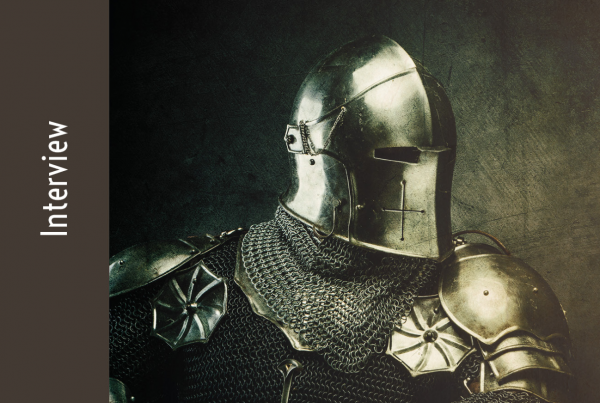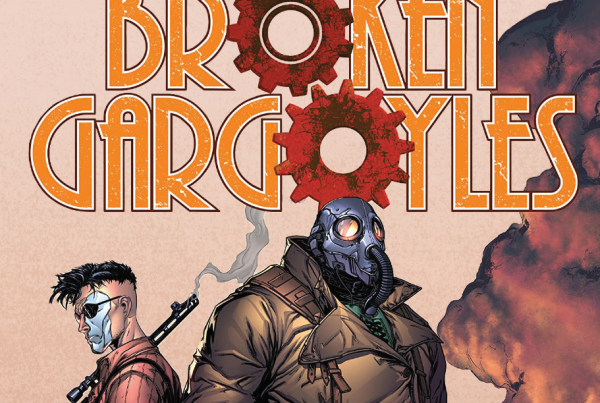Joseph McGuire is a game designer, and creator of cyberpunk skirmish wargame Reality’s Edge and post-apocalyptic skirmish wargame This Is Not a Test.
Hi, Joseph, thanks for taking the time to talk to Parallel Worlds. Could you tell us a little about yourself? Who are you and where are you from?
Greetings! Happy to talk about myself, as any good self-promoter would. Well, I’ve been a miniatures wargamer since 1997. The same year I discovered a life-changing copy of the Games Workshop product catalogue. I started as a hardcore GW fanboy, and still am; but I also discovered historical gaming about a decade ago, and now I am really passionate about indie miniatures gaming, which is small companies producing really cool and creative games.
In real life I am a humble civil servant and married father of one. I do not do this full-time — much as I would love to — but the day job affords me the ability to not die of starvation or exposure to the elements. I deeply respect and envy the game designers who have the drive and creative energy to go full-time.
Most of the time I’m hanging out with family, playing video games, building Lego, or writing various gaming supplements. Sadly, with the onset of COVID19, my ability to play games with friends has greatly diminished.
You wrote Reality’s Edge in 2019, published by Osprey. What inspired you to develop the game?
Oh, boy. Reality’s Edge is a beast and getting it from my head to print was an epic journey. Like any nerd growing up in the 80s and 90s, I was obsessed with cyberpunk. Mondo 2000, the Hacker’s Manifesto, The Sprawl Trilogy, and so on and so on. The game took about two years to write, which is standard for me for a book of that size. My inspiration was a mix of the original aforementioned source material and cyberpunk roleplaying games like Shadowrun and Cyberpunk. I have a few genres that I love, and after I got my first love of the post-apocalypse out with my first game This Is Not a Test, I was mentally ready to tackle cyberpunk.
When I write rules I prefer to give players options. They don’t have to use all those options, and in some ways it can be counterproductive as you have to mull said options before playing — which can be daunting. For me, when playing any game, I love writing up the warband or character and exploring all the options they can take. Before hitting the table, I have deep-dived into the game, making it my own. So Reality’s Edge focuses on that as one of its main design vectors, and players who like that kind of thing are in for a treat.
Another hallmark of my games is that I design around tropes first. Reality’s Edge has every cyberpunk trope you can think of. Drugs, augmented reality, virtual reality, cyberware, a dystopian sprawl setting, katana-wielding ronins, corporate overreach, and more. My goal was not to leave anything off the table. How to mix all of these elements is why the game took two years to write.
I used my mechanics from This Is Not a Test, but I wanted to add hacking and a bit more crunch since I wanted smaller crews of six or less models. Of course, I went through like six versions of hacking rules and I’m still not 100% happy with implementation. But as it is often said, perfect is the enemy of the good.
How did you go about getting Osprey to publish your game?
Normally publishing works that way, but I was kind of recruited. Joe McCullough of Frostgrave fame recommended me to Osprey. Joe and I have circled in the same orbits for a while, first as fellow employees of a gaming store, and then we would meet at various conventions when he came to the US. Based on the success of This Is Not a Test I think they saw that I was capable of delivering a game and they reached out to me to write a science fiction game. I pitched a cyberpunk game to them and the deal was made.
I will say that Osprey was very good to work with. They asked for 40,000 words and I delivered 80,000, and they did not balk at too much. The final book is beautiful, with great art by Thomas Elliot. They were great to partner with. The benefit to working with Osprey is that they handle all the costs, distribution, editing assistance, and start-up promotion. But despite that I felt them to be pretty hands-off in the sense that I made the book I wanted.
Reality’s Edge is miniatures line-agnostic; players can basically use whatever miniatures they like to play the game. How does that affect the way in which you approach the design of the game?
As I said before I tend to write around tropes. I knew that I wanted street samurai, deckers, and so forth. I would say that I had a strong 90s cyberpunk aesthetic for the game, but not an overarching story. I wanted players to develop their own Sprawls and place them wherever they wanted. I gave enough world depth to explain why the world is the way it is and the basics technology-wise, but I left everything else up to the players.
I’ve long been a fan of agnostic miniatures games, as what a sprawl ronin should look like to me may not be the same to someone else. My version mirrors the Oni-masked sword-wielder in the book’s art, but honestly any model with a gun or sword would work. I wanted players to design their own aesthetic, and by not having a particular miniatures set, players can dive right in with miniatures they already have or choose just the right ones that match their cyberpunk visions. As for official miniatures, I do have a small range I am working on — but even they are fairly generic in a sense. There are not a lot of corporate-style models out there, so I wanted to have some nicely-dressed hackers, street ronin, and so on.
What are your plans for the future of Reality’s Edge?
As of now Osprey has not officially commissioned any new Reality’s Edge supplements, but Reality’s Edge has a future. Lacking any formal Osprey material, I plan to release Reality’s Edge material in the new indie game magazine Blaster, which is a collaboration anthology magazine I am working on with awesome game designers Ash Barker, Joe McCullough, Mike Hutchison, and Sean Sutter, and genius layout maestro Grey Horton. I don’t have a timetable yet, but expect to see more scenarios, more operative types, and probably an urban fantasy expansion with fantasy races and magic — because people like and want that kind of thing!
The urban sprawl setting of Reality’s Edge produces some interesting mechanics. I am thinking of the Shadow Backers, Avatars and Crowds, to name but a few. Could you explain some of the differences between Reality’s Edge and a ‘typical’ wargame?
Most wargames take place in fairly static environments. By that I mean that, other than the forces of all the players involved, there are no other participants. Reality’s Edge takes place in the Sprawl, a huge cityscape filled with millions of souls. The Sprawl is a living, breathing thing. First, you have crowds to contend with. They can slow your models down, make a great place to blend into, and they panic. They may even attack if pushed too far. I saw this idea first in Gangs of Rome and I liked it enough to incorporate a variant into my rules. Second, the game has an entire section dedicated to random non-player characters that could show up. From chromed-up thrill killers and drunk salarymen to street gangers and corporate security — the reviled CORSEC.
Another unique characteristic is how the game handles hacking. You have your standard deckers that can hack local networks or anything physical they can see they can see. But the game also has a virtual component. You have a remote hacker called the Shadow Backer who is following the crew around in cyberspace. The game assumes that cyberspace closely models the real world, as cyber architects are a lazy bunch and are not going to model the local virtual space into anything fancy. They are going to replicate real life and call it a day. This allows us to introduce virtual models onto the board, as the virtual and the real will mirror each other. So you can deploy a digital avatar that floats about the board, ignoring terrain, and attacking other virtual models — and even attacking other models by following the digital data trails they leave behind. This also gives players awesome conversion potential, as there are no rules as to what a digital avatar has to look like — only that they be about 32mm or smaller. I’ve seen historical models like samurai painted neon green, translucent fantasy miniatures, the occasional anime girl…
Do you have any advice for other prospective game designers?
The first and most important advice I was given and that I now give is that ideas are generally worthless by themselves. Everyone has them, but most never act on them. A game designer needs to produce. I’m a slow writer and I’m amazed at the outputs of the likes of Joe McCullough or Mark Latham, but to be successful you have to write. There is no right answer on how simple or complex your first set of rules has to be, or even what genre; but you have to have an idea, put it to paper, and show it to someone else. After that it’s simply a matter of laying another stone on top of that first foundation stone and keeping the momentum going. Not everything you make will be great, and people will tell you it sucks. But you have to take that first step or the journey will never begin.
Do you play games by other designers?
Oh yes. I’ve played a lot of games over the years, but my current want-to-plays are Frostgrave and Rangers of Shadow Deep. I am infinitely jealous of Joe’s casual authorial tone and his ability to boil down a complex idea into a few rules. I also really want to get a local group going for Relic Blade, which has a great action dice system. Beyond that my favourite game designers are Andy Chambers, Rick Priestly, Mark Latham, Tuomas Pirinen, and many, many others.
What are you reading at the moment?
I just finished Peace Talks in the Dresden series by Jim Butcher. I also have a rotating shortlist of gaming books that I read for fun and research. Right now I’m working through the Fallout roleplaying game by Modiphius and rereading a patchwork of all post-apocalypse roleplaying games like Redline and Post-Apocalypse Hero.
Do you play video games?
Yes. I’m an old-school gamer because I’m old. My favourite games as a kid were A Link to the Past, Super Metroid, and the Final Fantasy roleplaying games. Right now I’ve been playing Borderlands 3. I also love all of the Fallout games — barring 76 which I have not played due to its lack of solo campaign — and the Borderlands series. If you had to make me choose my two favourite video games of all time, they would be Final Fantasy Tactics and probably Borderlands 2/Fallout 3.
Great stuff. We really appreciate you taking the time to talk to Parallel Worlds, and wish you all the best!






